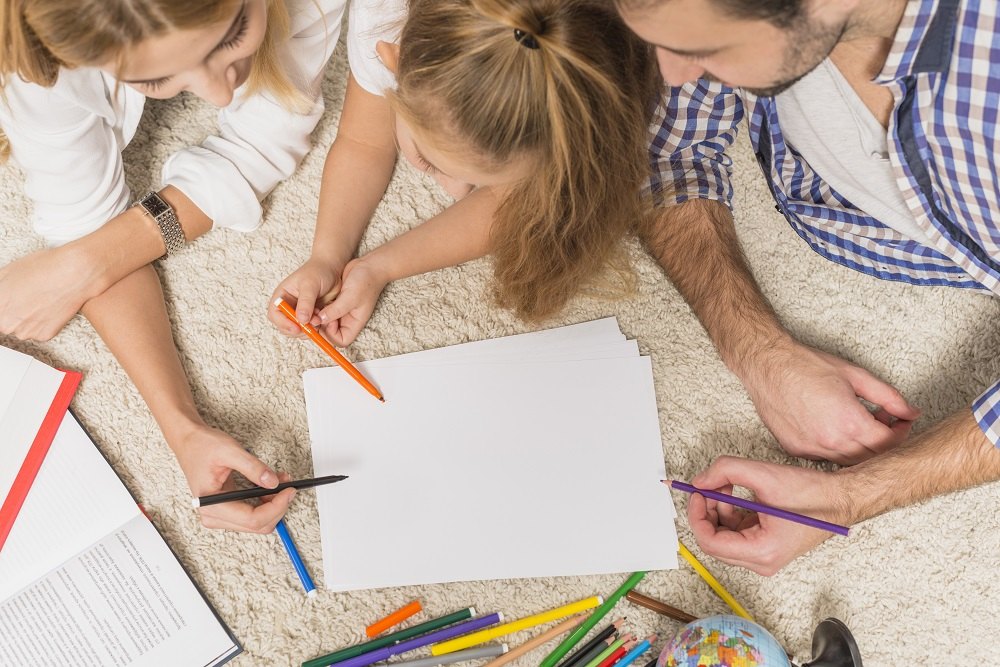Every child is unique and has their own interests and preferences. However, when we see others painting and coloring, we naturally expect our own little ones to have the same passion for art. But what should we do when our child shows no interest in drawing or coloring? Don’t worry! There are many ways to support and develop a toddler’s creativity and imagination, even if they are not fond of traditional artistic techniques.
Tips for parents whose children do not like to draw or color
- Look for other forms of artistic expression: Drawing and coloring are just a part of the vast world of art. Children can explore and express their creativity in many different ways. Encourage your child to experiment with other artistic forms, such as sculpture, decoupage, origami, cutting and gluing, or even creating collages. It may turn out that painting with brushes is not for your child, but they might love modeling clay or creating three-dimensional artworks. Playing with clay, play dough, or salt dough can be just as exciting and developmental. The child can create various shapes, characters, or elements from their imagination. This way, they develop their fine motor skills and stimulate their imagination.
- Discover their passions: Every child has their own interests and talents. Instead of forcing them to draw or color, take an interest in what truly fascinates them. Is your child interested in music, dance, sports, writing, or reading? Help them develop these interests while allowing them to express themselves through these fields. Creating their own choreography to their favorite song or staging a small theater performance are wonderful ways to foster creativity and self-confidence. It may turn out that your child is an artist in another form that you have yet to discover!
- Suggest alternative artistic tools: Drawing and coloring with traditional pencils or crayons do not have to be the only option. There are many other artistic tools that can capture your child’s attention. Try finger paints, oil pastels, markers, tailor’s chalk, watercolors, or marker pens. A variety of tools can spark curiosity and inspire experimentation.
- Discover new techniques: Often, childrenthey do not like drawing and coloring because they feel awkward with the tools and do not know how to start. Show them different techniques that can make the process more interesting. For example, you can suggest painting with a brush on large cardboard, creating patterns using stamps or stencils, painting with water on the sidewalk, or experimenting with mixing different colors of paint. Introducing new techniques can help the child discover their hidden artistic talents.
- Allow for creative freedom: Not all artwork has to be perfect or realistic. Encourage your child to create in their own way. Let them experiment, play with colors and shapes. Whether the final piece resembles something recognizable or is abstract, it is important that your child feels free to express their creativity.
- Creating with everyday objects: Stimulating creativity in a child does not have to be complicated or expensive. Collecting various household items, such as boxes, corks, plastic bottles, or scraps of fabric, can become an excellent opportunity for creative experimentation. The child can create models, constructions, or even build their own miniatures of houses or robots.
- Exploring nature: If your child does not feel fascinated by drawing on paper, they may love observing the surrounding world instead. Go for walks in the park, botanical garden, or on trips to the forest. During these adventures, you can look for interesting stones, leaves, pine cones, or insects. At home, you can create collections together, describe observations in a naturalist’s journal, or talk about various natural phenomena.
- Sensory art: Some children may have difficulty painting independently, but they may love sensory experiences. You can create special bowls with paint and various materials, such as flour, rice, glue, salt, or sand. The child will have the opportunity to experiment with different textures and sensations while touching and mixing these substances.
- Visit art galleries and museums: Visiting an art gallery or museum can be an inspiring experience for the child. Interacting with different types of artworks can spark imagination and open new horizons. Encourage your child to observe, ask questions, and discuss the exhibited works. This can help develop their interest and understanding of the diversity of art.
Remember that every child has their own pace of development and preferences. It is important not to impose your expectations on them, but to support them in discovering and expressing creativity in their own way. Some children simply need more time and space to find their artistic path. After all, the most important thing is to love and appreciate your child as they are, regardless of whether they have artistic talent or not.
How to motivate a child to draw?
Drawing is a wonderful way to express creativity and develop artistic skills. If you notice that your child is not very interested in drawing, don’t worry! There are many ways to motivate them to explore this fascinating world of art. Here are some friendly and interesting ways that can help ignite your little one’s passion.
-
Create together: Encourage your child to draw together. Children often imitate their parents’ behaviors. If you want to motivate your child to draw, you can start by showing your interest in this activity. Sit next to your child and start drawing yourself. Remember, it’s about sharing the experience, not creating a perfect piece of art. Choose a theme or story that you want to depict on paper, and then draw together and talk about your ideas. This will create a pleasant atmosphere and show your child that drawing can be a fun activity to share.
- Use a variety of materials: Offer different drawing tools, such as crayons, markers, paints, pastels, or coloring books. Give your child the opportunity to experiment and choose which style or technique they would like to use. The variety of materials makes drawing more interesting and intriguing. Show how different tools can affect the final result of the drawing. It may turn out that your child is more eager to experiment when they have access to different types of paints and markers. You can also browse art books together or watch inspiring films or animations to spark your child’s imagination.
- Create an art space: Set up a small art corner at home where your child will have their own area for drawing. This could be a special table or drawing stand where materials for creating are always available. Make sure the space is well-lit and comfortable. Together, choose favorite paintings or illustrations to hang on the wall to inspire your child to draw. It is important that this space is accessible for the childat any time and to have a sense that drawing is something enjoyable and personal.
- Make it a fun challenge: Kids love challenges and competition. You can suggest to your child to create a drawing on a specific topic within a limited time. For example, you might say, “Can you draw your favorite animal in two minutes?”. This will help spark interest and motivation, as well as develop quick thinking skills and a creative approach to drawing.
- Positive support and praise: Remember to appreciate and praise your child’s creativity. Regardless of the final results, it is important to express appreciation for their effort and ingenuity. Encourage the child to talk about their drawings, ask questions, and listen attentively. This will help them develop confidence and interest in drawing.
-
Organize “exhibitions” and share the works: Create a small “art exhibition” at home where the child can showcase their drawings. You can also organize a family gathering where you share your works and talk about them. This will help the child understand that their creativity is valuable and can be admired by others.
Remember that every child has their own pace and preferences. They should not be forced to draw if they do not want to. It is important that drawing is a pleasure for them and a way to express themselves. Give the child time, encouragement, and support, and their passion for drawing may awaken and develop naturally.


